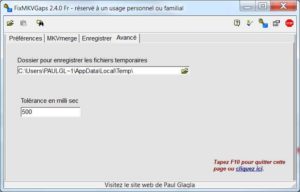
When you have opened the Settings page ( F10 ) you can click the Advanced tab to access two so-called advanced settings. They are only useful for certain particular uses, and as a rule it is recommended not to touch them.
- The first advanced setting is to choose the folder in which will be located the temporary timecode files that allow mkvmerge to produce a video that keeps the audio / video synchronization. In general, FixMKVGaps chooses the Windows temporary files folder, which already exists and contains only temporary files that different Windows-based applications have created.
Note that temporary timecode files are only useful during the mkvmerge repair operation. They are in principle destroyed if this operation comes to an end. But sometimes if errors or cancellations occur, these files may remain in the temporary files folder, and you will have to delete them directly by hand.
- The second advanced setting is the tolerance in milliseconds used to define a discontinuity of timestamps, that is to say a gap. If you decrease this value, then the tolerance will be less strong and more gaps will be detected. It is recommended to leave this value at 500 which seems a good compromise in all the cases that I have tested. This ensures that the video will never block more than half a second and limit the number of gaps to be fixed by considering only the largest gaps.
You must be aware that each fixed gap improves indeed the fluidity of playing the video, but removes some images and a tiny portion of audio. If you over-multiply the number of gaps to fix, then the repair could do more harm than good to the original video. In particular, I have found that if Tolerance is below 100 there may be problems that begin to be visible.

